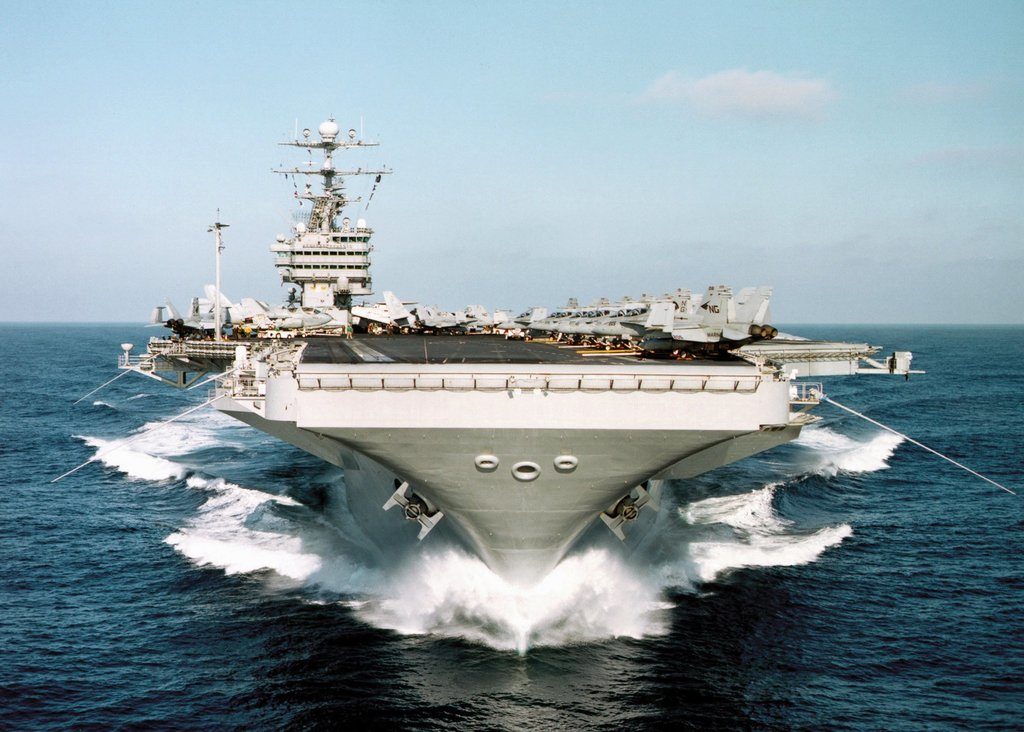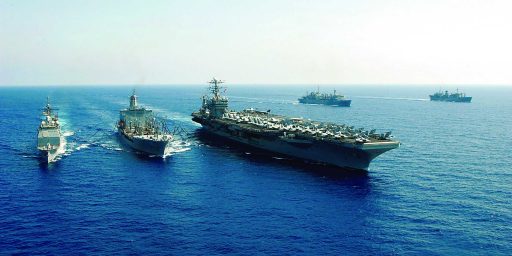Navy Chief: Get Past Ship Numbers
The raw number of vessels is not the best metric of naval power.

The Chief of Naval Operations wants people to stop worrying about how many ships are in the fleet and start thinking in terms of combat effectiveness.
The Navy’s top officer wants people to stop thinking about thesize of the fleet in terms of how many ships it has, and instead start thinking about what those ships can do.
Asked whether he thought unmanned ships would ultimately count against the Navy’s battle force of ships, which now stands at 289, Chief of Naval Operations Adm. John Richardson said he’d like to move away from thinking in terms of ship count.
“It’s kind of a theoretical discussion,” Richardson said. “The thing that really matters is how much naval power do those platforms deliver. That’s the thing we’re after, I’m not so caught up in what counts against the battle force.
“Because if that platform, manned or unmanned, delivers a requisite amount of naval power that’s available and assignable by the theater commander, then OK, that contributes to naval power.”
—David B. Larter, DefenseNews, “The Navy’s top officer wants you to stop counting his ships“
This would seem like a blinding flash of the obvious but it’s actually a somewhat bold, if not heretical, stance coming from a CNO.
The distinction may seem like an exercise in semantics, but for Congress, the number of ships in the fleet has always been a useful metric when discussing the need for a larger or smaller Navy. Even President Ronald Reagan made a specific ship count — 600 ships — an organizing goal and rallying cry.
Today, lawmakers in both the House and Senate have made the Navy’s current force-structure assessment goal of 355 ships a focal point of their efforts.Going after a concept like “total naval power” is somewhat more abstract and difficult to fit on a bumper sticker. However, the danger of chasing ship counts is that it could drive the Navy toward buying platforms it doesn’t need to meet a specific number, Richardson said.
“We have to be very careful to make sure that we’re not constructing something that counts on a tally but doesn’t contribute to naval power,” Richardson said. “At the end of the day, the real metric is power.”
The question will become relevant as the Navy prepares to roll out its force structure assessment later this year, which service leaders have intimated will likely grow the number of ships it needs to support the National Defense Strategy. Richardson’s answer represents a view widely held inside the Navy: that simply counting hulls is inadequate.
Again, this seems obvious. And it’s crucial in resolving such debates as to whether it makes sense to devote enormous resources to refueling the Truman at its midlife or, indeed, whether the aircraft carrier concept remains relevant if we’re basing our force posture around a future superpower conflict.
Still, smart people disagree.
However, others have argued that quantity has a quality of its own, and that for a variety of demands placed on the fleet outside of being able to fight and win a war — presence, training with partners and freedom of navigation operations, to name a few — at some point the service will need enough hulls to fulfill the mission.
Jerry Hendrix, a retired Navy captain and analyst with Telemus Group, has argued for years that numbers are critical to the Navy’s role in preserving the peace. Citing the 2007 maritime strategy, Hendrix said numbers matter.“In that strategy they found that preserving the peace was at least as important a mission as winning the war,” Hendrix said. “This idea of peacetime presence is crucial, and capacity is very critical in the peace preservation mission. You can’t surge trust and you certainly can’t be virtually present.”
Hendrix isn’t wrong. Moreso than any of the other military services, the Navy has an everyday mission other than preparing for combat and humanitarian assistance/disaster response missions. Those do indeed require platforms.
Then again, Richardson surely doesn’t dispute that. He’s making a broader argument: that we shouldn’t assess the Navy’s readiness purely in terms of vessels. The old “600-ship Navy” championed by John Lehman continues to have resonance and many in Congress and the halls of the Pentagon remain attached to that outdated metric. Ditto the number of carrier battle groups. Richardson is simply saying we need to think beyond raw numbers, not that numbers are meaningless.
The Army and Marine Corps have similar habits, thinking in terms of the number of soldiers/Marines, divisions, corps, and the like. The number of men under arms is a convenient shorthand for combat power. But the ground services are further along culturally in understanding that the raw numbers are only part of the story.






We presently have the smallest fleet size in a century and the rate at which new ships are being commissioned has fallen to a low level as well. I, too, remember the plans for a 600 ship navy 30 years ago. Where was this argument then? Is this a serious argument or just whistling past a graveyard?
You know the person in high school who claims grades aren’t everything, usually has bad grades? I claimed that a lot 😉
This is a case of “it’s not what you have, but what you can do with it,” and that depends on battle plans, policies, and foreign affairs. But the Iraq War showed it’s important to 1) have the armed forces you need, and 2) have a realistic plan. We’re also past the stage where raw numbers are everything, like a superior force on the offensive may not need three times the man power against a defender; this was so as far back as 1991.
Past these generalities, I’m content to leave the military to the professionals. But this also may stir Dennison into wanting a bigger navy because bigger is better, and how dare anyone say his navy is small.
This post inspires a lot of disconnected reactions:
1) Why didn’t you link to the article you quoted?
2) I understand that I’m not the target demographic for your post or its headline, but nevertheless, I hear a dissonant clang when I read “Navy Chief” only to realize that you’re not talking about someone like me, but the CNO. Yes, I realize that hints at my narcissism, but truth is truth.
3) I don’t believe that anyone who is qualified to opine on this matter has ever thought that raw count of ships is useful for anything more than a general idea of where we should be trying to go. The number of ships is the output of the planning process, not the input.
4) For a split second, I wondered who resurrected Jimi Hendrix to ask him about fleet size.
5) That being said, I would think that Captain Hendrix’s thoughts on “preserving the peace” and “peacetime presence” are considerations that should be included in force structure planning. There are many factors that should be included in this consideration, and some are more important than others. There will be tradeoffs, and some will be unhappy with the results. This is as it has ever been, and as it shall ever be.
Congress likes the idea of 600 ships because they can do the math and figure out how many of those ships, planes, components will be built in their district. Strategy is irrelevant, this is about pork.
What concerns me is the sense that we aren’t just fighting the last war, we’re fighting like six wars ago, still thinking it’s all about aircraft carriers and battle groups. But look where the Navy is likely to be deployed: the Persian Gulf, the Red Sea, the Straits of Malacca, Sea of Japan, South China Sea. What do all those spots have in common? They are all narrow or confined bodies of water where submarines, drones land-based anti-ship missiles, and remotely-controlled small surface craft can be deployed against us.
We are focusing on force projection – and indeed carriers are great tools for beating up on third world forces. But what about the defense of those carriers? Should we not be nervous about putting billions of dollars worth of irreplaceable hardware into tight spots where a relatively weak enemy (let alone China) could surge great numbers of ASMss and drones and mall subs? A carrier all by itself costs 5 billion. You can buy 20 nice, new diesel-electric subs for that. Is our 5 billion dollar carrier and our billion or so in support vessels able to survive an attack by 20 subs in the Red Sea or the Straits of Malacca?
Too many eggs in too few baskets. There is something to be said for more ships of simpler, cheaper design. But I don’t think there’s a rational argument for building more carrier groups.
As a Navy guy myself (originally, before I changed to the dark side), that is a really radical thing for a CNO to say.
The problem with that is that the Navy will never have all of its combat power at full readiness. The rule of thumb is that 1/3 of the force is ready and/or deployed, 1/3 has just returned or is preparing to deploy, and 1/3 is in the yard, undergoing refits, maintenance or whatever. So numbers do matter.
The second thing one needs to look at is deployment times and OPTEMPO. The Navy doubled the number of forward-deployed forces in recent, yet those forces don’t have sufficient time for training or certifications – one of the major factors that lead to a spate of deadly ship collisions in recent years. That fact alone shows the number of ships is not able to meet the required taskings in a sustainable way. It seems bizarre to assert that we can say we need double the ships forward-deployed, but can do that with fewer numbers, without any negative impacts.
When I was in the Navy in the 90’s we were really busy and deployment times were 6 months. Today, they are now 8 months. Oh, and like with the other services, low-density/high-demand units are busier than ever.
And the missions aren’t going away. If we are to sustain the force with a smaller Navy, then we need to reduce the mission-set – meaning fewer operational deployments and mission taskings.
The sad reality is that the Navy, like the other services, has proven itself to be completely incompetent when it comes to acquisitions, at least in terms of meeting budgets and timelines. The result has been insufficient funds to buy the assets we need. We wouldn’t be in this mess if the DoD could actually procure new platforms on-time and on-budget instead of decades-lates at multiple times the estimated cost.
@Andy:
There’ another rather critical element: humans, or more specifically, the lack of humans interested in serving.
Not much point in building ships if we don’t have the sailors.
@michael reynolds:
In a real war, we won’t put carriers in those tight spots. Yes, carriers are great at power projection (thanks to their aircraft), which means they can interdict those small bodies of water while remaining mobile and difficult to attack in blue waters. I think carriers will continue to be relevant because there aren’t alternatives that can do what a carrier can.
Very true, and another big problem.
@Andy:
I don’t think it’s possible, given the effective range of carrier aircraft, to project significant force against North Korea without positioning the carrier in the Sea of Japan or God forbid the Yellow Sea. The Red Sea is what, about 1000 miles long? Where do we park a carrier that could operate against Sudan or Eritrea or southern Egypt? Ditto the Gulf and Iran. Obviously the further out we stay for safety, the less effective our planes are.
I don’t like the math of pitting a 10 billion dollar carrier group against cheap subs and cheap drones and USS Cole style attacks by cheap small surface craft. It’s all good so long as we’re fighting people who can’t fight back. But in the Gulf there are places where you can hit a carrier with field artillery, let alone missiles.
@michael reynolds:
Russia is currently destroying the Republic with a bunch of hackers, a complicit Majority Leader, and a useful idiot in the White House.
Carriers seem ill-equipped to counter the threat.
@Boyd:
Oversight. We recently implemented a major WordPress upgrade that radically changed the writing interface to something completely unlike its predecessor. Because it enables it, I now frequently include a bibliographic cite under the first mention (as I’ve now appended here) but sometimes style do it inline, depending on what I think makes most sense. But I sometimes forget to do the former because it’s a new workflow.
Yes, good point. I’m going for shorthand for the lay reader but, only tangentially exposed to Navy culture via the Marines, forget that some might have your reaction.
@michael reynolds:
Yes. And, in fairness, defense wonks (in uniform and out) are furiously trying to figure out the so-called Anti-Access/Area Denial (A2/AD) problem. But, as you say, the Navy has other missions as well so it’s not like the whole fleet can be configured around a we-hope-to-hell-it-never-happens fight with the PLAN.
@Daryl and his brother Darryl: Obviously, not a problem within the CNO’s remit.
@michael reynolds:
The Sea of Japan is pretty big. North Korea’s Navy isn’t very capable and their ability to find and target anything beyond about 50 miles from the coast isn’t very good. And even if you put the carrier on the east side of Japan, the distances are about the same as what the Navy was doing from the Gulf of Oman into Afghanistan in 2001. And even today the USN launches strikes on Afghanistan from the Persian Gulf.
Same thing with Eritrea or Sudan. For Iran, there’s the Arabian sea.
Keep a couple of things in mind – there are a lot of factors to take into account and the positions and use of high-value assets will depend on the objectives as well as the current threat – which will change over time. Carriers can remain at a safe distance until the threat is diminished, then move closer to increase the sortie rate.
Finally, the biggest problem for our potential adversaries is getting targeting data. You may have a 1000 mile range anti-ship cruise missile, or a drone, or whatever, but that doesn’t mean much if you don’t have the targeting data to utilize it. Knowing where a carrier will be after a 2-hour missile flight-time (or 4-8 hour drone flight time) is not easy for most countries, including the US, which is something we’ve been trying to improve since the early 1990’s.
@Andy:
And don’t forget carriers aren’t allowed to go out by themselves. They are surrounded by escorts that carry lots of guns and missiles. I suppose one can google “carrier battle group” and find out exact compositions.
As far as I know, modern US carriers have no weapons other than their aircraft, save for point-defense guns. They depend on their escorts for defense against attack.
I have no idea where the “even” came from. Reagan was a Republican, that he wanted to increase defense spending doesn’t seem to rate an even.
@michael reynolds: You’re worried about the Red Sea and the Straits of Malacca. To justify 600 ships, the Navy Secretary was planning, in case of war with the Soviets, to put a carrier group in the Barents Sea (Murmansk, home of the Soviet Northern Fleet).
The linked Defense News article is somewhat unsatisfactory. It says the CNO made the statement in response to a question, but not who asked or in what forum. Not sure how much weight to give this as a policy statement. And without context, it’s easy to see this statement as a proxy for wanting bigger, higher dollar ships.
I’m absolutely the wrong person to be talking about this topic, but I will note that one of the dubious messages I came away from grad school with was *the only way you know that your program is important is when the institution spends money on it*. My inclination was always to 1) see that attitude as cynical (although very human) and 2) believe that a certain amount of “government waste” stems from this very attitude. For me, the fact that we seem to have a CNO who is not caught up in that mindset is both refreshing and comforting as relates to “bang-for-the-buck” as I have to believe that he is aware and competent in that arena. YMMV.
@Just nutha ignint cracker:
Yes. It’s worth noting, though, that he’s about to hang up his spurs and head off the retirement. Confirmation hearings for his successor have already taken place.
@gVOR08: IIRC, one of the shibboleths of the era was “we must have the ability to fight on two fronts simultaneously.” The point was we needed bigger everything. (And smarter nothing, but that’s just about who the GOP are.)
@James Joyner: Given that fact, I’ll just presume on the general tenor of GOP thinking on anything, stick my head between my knees, and kiss my ass goodbye.
@Andy:
You make good points, and thanks for the insights. But there’s this:
And of course:
A guided missile destroyer taken out by a pontoon boat and a carrier virtually sunk by a Swedish sub worries me. That a modern Naval ship that’s sunk can only be replaced years later worries me as well. And the fact that the USN has not fought an opposing Navy since Okinawa is likewise not reassuring. Various state and non-state bad actors have had decades to contemplate the problem of American naval dominance. We think we know what they have, but we don’t know.
Unrelated: Finally got off my butt and became a patron!
@Just nutha ignint cracker:
I remember that. the standard (slogan?) was Two and a Half Wars. As though the US military, presumably with help from allies, could take on, say the USSR, China, and Iraq, at the same time.
The conventional wisdom about two-front wars is flawed, but no one goes about looking for two fronts.
@Just nutha ignint cracker:
And, years later, we decided to have two simultaneous wars — Iraq and Afghanistan.
Not 100% sure whether the “we have to be able to fight two wars simultaneously” was prescient, or causal. 90% sure causal.
“The sad reality is that the Navy, like the other services, has proven itself to be completely incompetent when it comes to acquisitions, at least in terms of meeting budgets and timelines.”
Nephew’s significant other does logistics for the Navy. However bad you think they are at wasting money with inefficiencies and squabbles over budgets, it is probably worse.
Steve
@michael reynolds: Diesel subs work great as coastal defense but they have limited range and at 6knts you’re going to need to know where the Carrier group is going to be well in advance if you want to have a chance at attacking. The sub in question returned to Sweden in A DRY DOCK” it didn’t even make the trip back home under it’s own power. I’ve been trying to figure out where the wargame occurred and near as I can find it was off the coast of California which is to the diesel’s advantage. Every other wargame where a diesel sub was able to get close was located near islands or a coastline.
It’s been well known for some time that clever usage of sea geography can allow for a modern diesel sub to get very close undetected (it’s one of the leading arguments FOR diesel power). Especially if there are islands or a coastline nearby. The US can’t really run diesel subs because it would require an extensive network of refueling stations due to the very limited range afforded via diesel. SO what that means is if the carrier group is floating along in blue water a diesel sub is going to have issues even getting to it due to lack of speed and endurance/range. The subs would be forced to run on the surface or near the surface with a snorkel and at that point they are easy to detect.
Oh and here’s some more stuff for you to worry about.
https://en.wikipedia.org/wiki/Millennium_Challenge_2002
Asymmetrical warfare is a bitch.
EDIT : The Australians pulled off a similar feat with their diesel subs in a wargame that was also near islands so the sub could hide effectively. The captain of the Australian sub straight up played Men at work’s “down under” over the coms when they were in position for a torpedo launch.
Meant to add that even if they have a stirling engine or something to recharge the batteries without surfacing they are still going to be forced to make a lot of noise to move at a fast enough speed to get into position for the slow creep attack.
@Andy: Ive worked for Defense Industrial Base contractors–cost overuns and delays are engineered into the acquisitions to increase profit margin. Is there incompetence on the Gov’t side–of course a little–but no one ever seems to place any responsibility on the big contractors for their business model to sandbag the gov’t to milk extra profits. Its not as if DOD can fire Boeing 1/2 way through the acquisition and go with Mac-D for a jet. There are 4-5 companies that can engineer build major weapons systems at scale. They all run the same scam once they win a contract–they all donate to political parties so no one is going to do or say anything except to trash the acquisition professionals in the DOD who know they are playing a rigged game where they end up with the black eye from the taxpayers.
@Gustopher: Well to the degree that this will further the conversation, one of the points my Korean friends were inclined to make was that the only really significant industrial product the US still makes is weapons, and one has to have wars in order to use up inventory.
The other piece that nobody seems to be talking about is operating costs. If the remainder of the 355 ships the Navy would like to have were to magically appear over the next ten years, at zero procurement cost, the Navy could not afford to operate that fleet within foreseeable budgets. The Navy’s approach to this problem seems to be to assume that the money will show up from somewhere. It won’t.